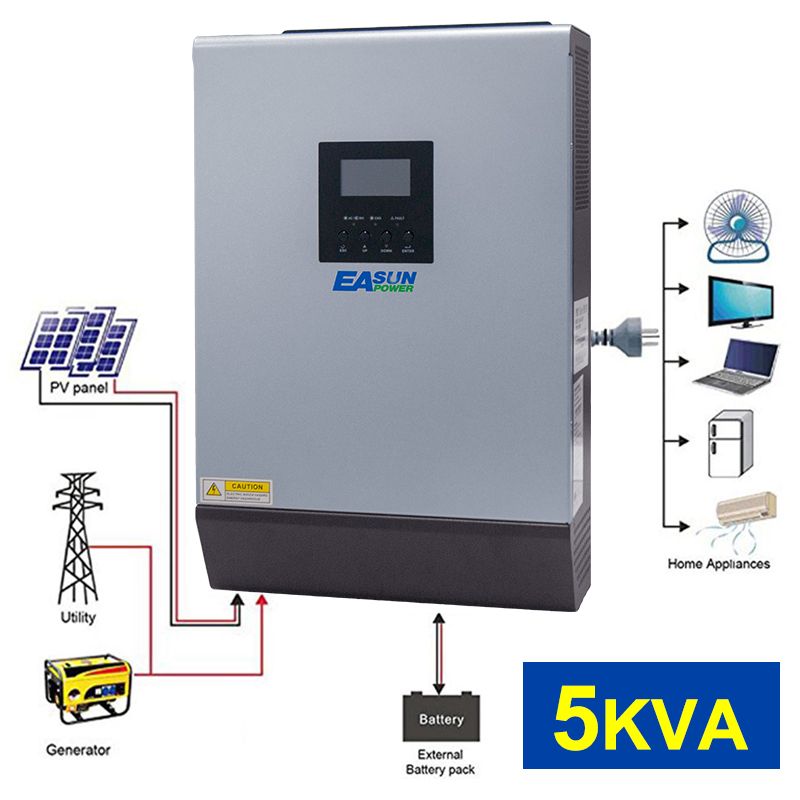A 5kVA (kilovolt-ampere) inverter is an electrical device that converts DC (direct current) power from a battery bank into AC (alternating current) power that can be used to run household appliances, office equipment, or other electrical devices.
The term “kVA” refers to the apparent power rating of the inverter, which is a measure of the maximum power that the inverter can deliver under ideal conditions.
A 5kVA inverter is typically used in homes, small offices, or commercial settings where there is a need for backup power during power outages or where there is no access to grid power.
It can power multiple appliances such as refrigerators, air conditioners, computers, and lighting systems.
However, it’s worth noting that the actual power output of an inverter may be lower than its kVA rating, depending on factors such as the efficiency of the inverter and the type and quality of the batteries used.
Therefore, it’s important to carefully consider your power requirements and consult with a professional before selecting and installing an inverter system.
What To Expect From A 5kVA Inverter

There are numerous benefits to expect from installing a 5kVA inverter
Cost Savings:
One major thing to expect from a 5kVA inverter is that it can help you save money on your energy bills over the long term.
You can generate your own electricity and reduce your reliance on grid power, which can be expensive in some areas, by using renewable energy sources such as solar panels, wind turbines, or hydroelectric generators.
A 5kVA inverter can also save you money on the costs of installing and maintaining a backup generator.
Power Quality:
Another vital thing to expect from installing a 5 kVA inverter is high-quality power that is stable, reliable, and free from surges or spikes that can damage sensitive electronic equipment.
This makes it an ideal power source for computers, medical equipment, and other devices that require a stable and consistent supply of electricity.
Energy Independence:
By generating your own electricity with a 5 kVA inverter, you can achieve a greater degree of energy independence and reduce your reliance on fossil fuels.
This can help you avoid the risks associated with power outages, fuel shortages, and price volatility.
Environmental Benefits:
A 5kVA inverter enables you to use renewable energy sources like solar or wind power, lowering your carbon footprint and contributing to a more sustainable future.
This is especially important for those concerned about the environmental impact of their energy consumption.
Noise-Free Operation:
A 5kVA inverter operates silently, which makes it ideal for use in residential or urban areas where noise pollution can be a concern.
Unlike backup generators, which can be loud and disruptive, a 5kVA inverter allows you to generate power without disturbing your neighbors or the environment.
Durability and Reliability:
A 5kVA inverter is designed to be durable and reliable, with a long lifespan and low maintenance requirements.
This makes it a cost-effective and practical solution for those who need a dependable source of power.
Increased Flexibility:
A 5kVA inverter gives you more freedom in terms of where and how you use power. It is ideal for camping, RVing, and boating because it can be used to power appliances and equipment in remote locations or during outdoor events.
A 5kVA inverter can also be integrated into a hybrid power system, which combines renewable energy sources with grid power, giving you more flexibility and control over your energy consumption.
To summarise, a 5kVA inverter provides numerous advantages, including cost savings, improved power quality, increased energy independence, environmental benefits, noise-free operation, durability and reliability, and increased flexibility.
Because of these advantages, it is an ideal solution for a wide range of applications, from residential to commercial, and industrial.
Disadvantages Of A 5kVA Inverter

While a 5kVA inverter has numerous benefits, there are also some potential disadvantages to consider:
- High Initial Cost: A 5kVA inverter can be expensive to purchase and install, especially if you also need to install a battery bank and other components. This initial cost may be prohibitive for some people, although it’s important to note that the system can provide long-term cost savings over the life of the system.
- Limited Power Output: While a 5kVA inverter can power a wide range of appliances and equipment, it may not be sufficient to meet the needs of larger homes or businesses with high power demands. In some cases, it may be necessary to install multiple inverters to meet the power requirements, which can add to the overall cost.
- Battery Maintenance: A 5kVA inverter requires a battery bank to store the electricity generated by the system. These batteries need to be maintained and replaced periodically, which can be a significant ongoing cost.
- Weather Dependence: If you are using a 5kVA inverter with renewable energy sources such as solar or wind power, the system’s output will depend on weather conditions. In areas with limited sunlight or wind, the system may not be able to generate enough electricity to meet your needs.
- Inverter Efficiency: Inverter efficiency can vary depending on the quality and type of inverter used. Lower-quality inverters may be less efficient and produce more heat, which can reduce the lifespan of the inverter and lead to higher operating costs.
- Noise and Heat: While a 5kVA inverter operates silently, it can generate heat when operating at full capacity, which may require additional ventilation or cooling measures. Additionally, some inverters may produce a humming noise, which can be a concern for some users.
In summary, a 5kVA inverter has potential disadvantages, including high initial cost, limited power output, battery maintenance, weather dependence, inverter efficiency, and noise/heat generation.
However, many of these issues can be mitigated with proper planning, installation, and maintenance, and the benefits of a 5kVA inverter may outweigh the drawbacks for many users.
Load Capacity
The load capacity of a 5kVA inverter depends on the power rating of the appliances or devices you intend to use with it.
The “kVA” rating of an inverter represents its maximum output capacity in terms of “kilo Volt-Amps.”
In simple terms, a 5kVA inverter can handle up to a total load of 5000 watts or 5 kilowatts (assuming a power factor of 1.0).
However, it’s important to note that the actual load capacity may be lower due to various factors such as the efficiency of the inverter, the power factor of the connected loads, and the battery bank capacity.
As a general rule of thumb, it’s recommended to not exceed 80% of the maximum rated load capacity of the inverter to ensure optimal performance and to prolong the life of the inverter and batteries.
Therefore, if you plan to use a 5kVA inverter, you should carefully consider the power requirements of the appliances and devices you intend to run simultaneously, and ensure that their combined power rating does not exceed the maximum load capacity of the inverter.
Prices
The prices of 5kVA inverters in Nigeria can vary depending on the brand, model, and features.
Here are some estimated price ranges for 5kVA inverters in Nigeria:
- Su-Kam Falcon Plus 5kVA Inverter: ₦500,000 – ₦700,000
- Luminous Zelio+ 5kVA Inverter: ₦450,000 – ₦600,000
- Microtek UPS SEBz 5000 VA Pure Sine Wave Inverter: ₦350,000 – ₦500,000
- Exide 5kVA Pure Sine Wave Inverter: ₦350,000 – ₦500,000
- APC 5kVA Smart-UPS On-Line Inverter: ₦700,000 – ₦900,000
- Delta Electronics 5kVA Online Double Conversion UPS: ₦600,000 – ₦800,000
- Tripp Lite 5kVA SmartOnline Double-Conversion UPS: ₦700,000 – ₦900,000
- Eaton 5kVA 9PX UPS: ₦800,000 – ₦1,000,000
- CyberPower 5kVA Smart App Sinewave PR Inverter: ₦550,000 – ₦750,000
- Vertiv Liebert GXT5-5000RT230E 5kVA Online UPS: ₦750,000 – ₦950,000
Please note that these prices are estimates and may vary depending on your location and the availability of the product.
It’s recommended to compare prices from multiple vendors and consider factors such as warranty, customer support, and after-sales service when making a purchase decision.
Installation
The installation process for a 5kVA inverter typically involves the following steps:
- Choose a suitable location: Select a dry, cool, and well-ventilated area to install the inverter. Make sure that the location is easily accessible and away from direct sunlight, moisture, and heat sources.
- Mount the inverter: Fix the inverter securely on a wall or a flat surface using suitable screws and bolts. Ensure that the mounting surface can support the weight of the inverter and the batteries (if installed).
- Connect the batteries: Connect the batteries to the inverter using suitable cables and connectors. Follow the manufacturer’s instructions and ensure that the polarity of the connections is correct.
- Connect the loads: Connect the appliances and devices that you intend to run with the inverter to the AC output terminals of the inverter. Ensure that the wiring is done correctly and safely.
- Connect the solar panels (if applicable): If your 5kVA inverter is a solar inverter, connect the solar panels to the DC input terminals of the inverter. Follow the manufacturer’s instructions and ensure that the polarity of the connections is correct.
- Test the system: Turn on the inverter and test the system to ensure that everything is working correctly. Check the battery voltage, output voltage, and frequency using a multimeter or a suitable instrument.
It’s recommended to hire a professional electrician or an experienced technician to install the inverter, especially if you are not familiar with electrical wiring and safety precautions.
Make sure that the installation is done in compliance with local regulations and safety standards to avoid any accidents or damage to the equipment.
